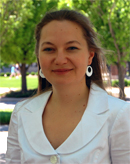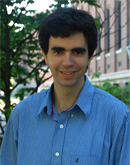Theoretical Chemistry
2009-12-08

Purdue University Assistant Professor Physical/Theoretical Chemistry
Goggles are not required when you visit the theory group. There are no wet labs, lasers, or mass spectrometers. Instead, these scientists use imagination and mathematical analysis to calculate the behavior of atoms, molecules, and matter. “We try to explain chemical experiments using two tools—our brain and our computers,” says Lyudmila Slipchenko, an assistant professor of physical and theoretical chemistry. Adam Wasserman, assistant professor of physical and theoretical chemistry, adds, “I don’t get wet in the lab. My calculations are done in pencil and paper or on the computer. Of course there needs to be someone doing the experiments.”
Both Purdue scientists stay up-to-date on the latest experimental research and also collaborate with colleagues. Slipchenko is working with Tim Zwier, M. G. Mellon Distinguished Professor of Physical Chemistry at Purdue, in analyzing the diphenylmethane molecule. “The idea is we can excite one part of the molecule and this electronic excitation transfers to other parts. A similar mechanism occurs in photosynthetic systems in biology,” Professor Slipchenko said. This research has several energy applications including artificial photosynthesis and solar cell technology.

Purdue University Assistant Professor Physical/Theoretical Chemistry
Theoretical chemistry is a contemporary field and computing power advancement has played an important role in its growth during the past two decades. Walter Kohn and John Pople were awarded the Nobel Prize in Chemistry in 1998 for their work in for their work in ab initio and density functional theories. Wasserman noted, “Computers played a huge part in the development. It was in the 1980s when the main theoretical TDDFT foundations were established, but success in chemistry started only recently.” “Anything we can’t do with our brains, we teach the computers to do,” explained Slipchenko. However there is more to theoretical chemistry than computers crunching numbers. “It is our job to then explain the phenomenon—make sure this is the result we expect and know why it happens,” she said.
Professor Wasserman predicts a future where the computer will be able to tell scientists everything that happens in the experiment. “The dream is that one will be able to just draw a molecule on the computer screen—no matter how large—and just click a button. The program will calculate everything about that molecule—physical properties, excited states,” he envisions.